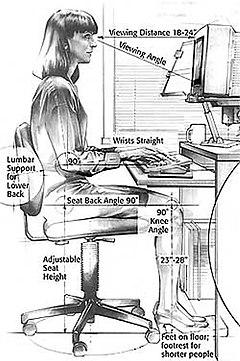Repetitive strain injury
| Repetitive strain injury | |
|---|---|
| Other names | Cumulative trauma disorders, repetitive stress injuries, repetitive motion injuries or disorders, occupational or sports overuse syndromes |
orthopedics | |
| Symptoms | Sore wrists, aching, pulsing pain, tingling, extremity weakness |
| Complications | Torn ligaments |
| Causes | Repetitive actions, poor technique |
| Risk factors | Sedentary lifestyle, smoking, alcohol consumption |
| Prevention | Proper technique, regular rests, regular exercise |
A repetitive strain injury (RSI) is an injury to part of the
Signs and symptoms
Some examples of symptoms experienced by patients with RSI are aching, pulsing pain, tingling and extremity weakness, initially presenting with intermittent discomfort and then with a higher degree of frequency.[3]
Definition
Repetitive strain injury (RSI) and associative trauma orders are
Examples of conditions that may sometimes be attributed to such causes include
A general worldwide increase since the 1970s in RSIs of the arms, hands, neck, and shoulder has been attributed to the widespread use in the workplace of keyboard entry devices, such as typewriters and computers, which require long periods of repetitive motions in a fixed posture.[7] Extreme temperatures have also been reported as risk factor for RSI.[8]
Risk factors
Occupational risk factors
Workers in certain fields are at risk of repetitive strains. Most occupational injuries are
Psychosocial factors
Factors such as personality differences to work-place organization problems. Certain workers may negatively perceive their work organization due to excessive work rate, long work hours, limited
Non-occupational factors
Age and gender are important risk factors for RSIs. The risk of RSI increases with age.
Diagnosis
RSIs are assessed using a number of objective clinical measures. These include effort-based tests such as grip and pinch strength, diagnostic tests such as
Treatment

There are no quick fixes for repetitive strain injuries. Early diagnosis is critical to limiting damage. For upper limb RSIs,
Although there are no "quick fixes" for RSI, there are effective approaches to its treatment and prevention.
A 2006 Canadian study found exercise in leisure time was strongly associated with decreased risk of developing an RSI.[20] Doctors sometimes recommend that those with RSI engage in specific strengthening exercises, for example to improve sitting posture, reduce excessive kyphosis, and potentially thoracic outlet syndrome.[21] Modifications of posture and arm use are often recommended.[6][22]
History
Although seemingly a modern phenomenon, RSIs have long been documented in the medical literature. In 1700, the Italian physician Bernardino Ramazzini first described RSI in more than 20 categories of industrial workers in Italy, including musicians and clerks.[23] Carpal tunnel syndrome was first identified by the British surgeon James Paget in 1854.[24] The April 1875 issue of The Graphic describes "telegraphic paralysis."[25]
The
Society
Specific sources of discomfort have been popularly referred to by terms such as
See also
- Computer vision syndrome
- Ergonomic keyboard
- List of repetitive strain injury software
- Maltron
- Microsoft ergonomic keyboards
Citations
- ^ a b c "Public Employees Occupational Safety and Health Program of the New Jersey Department of Health and Senior Services" (PDF). Archived from the original (PDF) on 23 July 2006.
- ^ a b CDC (28 March 2018). "Template Package 4". Centers for Disease Control and Prevention. Retrieved 12 March 2019.
- ^ "Repetitive Strain Injury: What is it and how is it caused?" (PDF). Selikoff Centers for Occupational Health. Archived from the original (PDF) on 3 February 2016. Retrieved 12 February 2016.
- ProQuest 1950381705. Archived from the originalon 6 August 2020. Retrieved 25 June 2019.
- ^ S2CID 1584416.
- ^ PMID 24338903.
- ^ "Welcome to the RSI Awareness Website". Rsi.org.uk. 17 November 2010. Retrieved 17 July 2014.
- PMID 7718827.
- NIOSHPublication 95-119. 1995.
- ^ Mining Publication: Risk Profile of Cumulative Trauma Disorders of the Arm and Hand in the U.S. Mining Industry U.S. CDC-NIOSH web site.
- ^ "CDC - Poultry Industry Workers - NIOSH Workplace Safety and Health Topic". www.cdc.gov. Retrieved 15 July 2016.
- ^ PMID 26386655.
- PMID 7832208.
- S2CID 38426326.
- S2CID 39663618.
- PMID 26856801.
- PMID 3358746.
- ^ "How to Use the R.I.C.E Method for Treating Injuries". 27 August 2014.
- ^ Copeland, CS (May–June 2014). "It's All in the Wrist...Or Is It? Symptoms, Sources, and Solutions for Repetitive Stress Injury" (PDF). Healthcare Journal of New Orleans.
- PMID 17394178.
- ISBN 978-0-8036-1584-7.
- ^ Berkeley Lab. Integrated Safety Management: Ergonomics Archived 5 August 2009 at the Wayback Machine. Website. Retrieved 9 July 2008.
- ^ Ramazzini (1700). De Morbis Artificum Diatriba [Diseases of Workers]. Modena.
- S2CID 30847057.
- ^ "Victorian London - Disease - 'telegraphic paralysis'".
- PMID 15576233.
- ^ Tinel, J. (1917). Nerve wounds. London: Baillère, Tindall and Cox.
- ^ Tinel, J. (1915). "Le signe du fourmillement dans les lésions des nerfs périphériques". Presse Médicale. 47: 388–389.
- ISBN 0-7216-8524-2.
- ^ "FMC Acquires Turner White Communications". 2 August 2017. Archived from the original on 30 November 2020. Retrieved 25 June 2019.
- S2CID 26563611.
- PMID 7266622.
- ^ "5 Modern Technology Strain Injuries | Carpal Tunnel Syndrome". Ctsplace.com. 30 December 2012. Archived from the original on 15 June 2014. Retrieved 17 July 2014.
- ^ "Raver's Wrist".
- ^ "How to Avoid Emacs Pinky".
External links
- Repetitive Strain Injuries at Curlie
- Musculoskeletal disorders from the European Agency for Safety and Health at Work (EU-OSHA)
- Amadio PC (January 2001). "Repetitive stress injury". J Bone Joint Surg Am. 83-A (1): 136–7, author reply 138–41. PMID 11205849.[permanent dead link]
